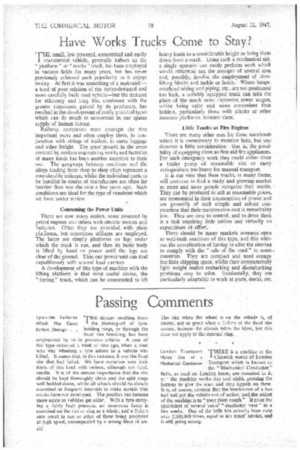Have Works Trucks Come to Stay . ?
Page 24

If you've noticed an error in this article please click here to report it so we can fix it.
THE small, low-powered, economical and easily manreuvred vehicle, generally knfiwn as the " platform" or " works "truck, has been employed in various fields for many years, but has never previously achieved such popularity as it enjoys to-day. At first it was something of a makeshif a kind of poor relation of the better-designed and more carefully built road vehicle--but the demand for efficiency and long life, combined with the greater experience gained by its producers, has resulted in the development of really practical types which can do much to economize in our sparse supply of human labour.
Railway, companies were amongst the first important users and often employ them, in conjunction with strings of trailers, to carry luggage and other freight. The great 'growth in the areas covered by modern engineering works and factories of many kinds has been another incentive to their use. The gangways between machines and the alleys leading from shop to shop often represent a considerable mileage, whilst the individual parts to be handled in course of manufacture are often far heavier than was the case a few years ago. Such conditions are ideal for the type of runabout which we have under review.
Concerning the Power Units There are now many makes, some powered by petrol engines and others with electric motors and batteries. Often they are provided, with plain platforms, but sometimes stillages are employed. The latter are simply platforms on legs under which the truck is run, and then its basic body is lifted by hand or power until the legs are clear of the ground. Thus one power unit can deal expeditiously with several load carriers.
A development of this type of machine with the lifting platform is that most useful device, the " tiering " truck, which can be constructed to lift heavy loads to a considerable height or bring them down from a stack. Using such a mechanical aid, a single operator can easily perform work which would otherwise tax the strength of several men and, possibly, involve the employment of slowlifting blocks and tackle or hoists. Where lamps, overhead wiring and piping, etc., are not positioned too high, a suitably equipped truck can take the place of the much more expensive tower wagon, whilst being safer and more convenient than ladders, particularly those with planks or other insecure platforms between them.
Little Trucks as Fire Engines There are many other uses for those runabouts which it is unnecessary to mention here, but one deserves a little consideration—that is, the possibility of equipping them as first-aid fire appliances. For such emergency work they could either draw a trailer pump of reasonable size or carry extinguishers too heavy for manual transport.
It is our view that these trucks, in many forms, will continue to find a ready and growing market as more and more people recognize their merits. They can be produced to sell at reasonable prices, are economical in their consumption of power and are generally of such simple and robust construction that their maintenance cost is remarkably low. They are easy to control, and to drive therit is a task requiring little tuition and virtually no expenditure of effort_ There should be many markets overseas open , to well-built machines of this type, and this without the complication of having to alter the steering to comply with the "rule of the road" in some . countries. They are compact and need occupy but little shipping space, whilst their comparatively light weight makes embarking and disembarking problems easy to solve. Incidentally, they are particularly adaptable to work at ports, docks, etc.
















































































